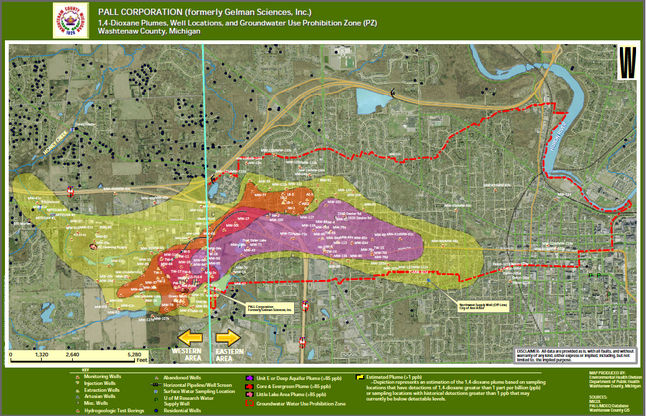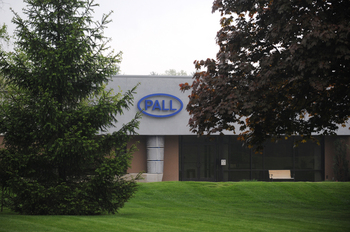Clik here to view.

The 1,4 dioxane plume in Ann Arbor and Scio Township as of Nov. 2012.
Courtesy of CARD
The company is perhaps more well-known locally by its previous name, Gelman Life Sciences, and for thousands of pounds of 1,4 dioxane that leaked into the groundwater more than 30 years ago — spreading a plume of contamination across miles of western Ann Arbor and parts of Scio Township.
Pall acquired Gelman in 1997 and is legally responsible for the cleanup.
The facility at 600 S. Wagner Road could be sold or leased without disturbing the remediation process, said Sybil Kolon, environmental quality analyst for the Michigan Department of Environmental Quality.
If the property was put up for sale, Pall would have to put a deed restriction on the property to notify all future owners of the contamination on the site, and to outline guidelines for future use.
“Even if a party is not liable, they have to manage it in such a way that (the contamination) is not exposed,” Kolon said.
E. Spaulding Clark, Scio Township supervisor, said there have been rumors of employee turnover and decreased operations at Pall Life Sciences for several years.
“It’s my impression that over a fair number of years, Pall has been moving its operations from the Ann Arbor area and consolidating them elsewhere,” Clark said. “The handwriting has been on the wall for the long time.”
Gelman Life Science’s Scio Township holdings had an assessed value of $6.9 million in 2013 — slightly more than the 2012 assessed value of $6.1 million. The property’s assessed value is the third largest in the township, according to Washtenaw County’s Equalization Department.
Clik here to view.

Pall Life Sciences at 600 S. Wagner Rd. in Scio Township.
Melanie Maxwell | AnnArbor.com file photo
Pall attempted to put three of the five buildings on the market in 2009.
The contaminated groundwater is treated in a building on-site at the Pall Life Sciences facility. Two holding lagoons on-site are used in the water treatment process.
Michael Gebhard is with the Coalition for Action on Remediation of Dioxane (CARD) and is a former environmental analyst for Washtenaw County.
“As a whole, there’s nothing to suggest that they would stop doing cleanup,” Gebhard said. “There’s a concern that they’ll do less than they are doing (now).”
Save for a team of employees directly involved with the environmental remediation of the 1,4 dioxane plume, Pall Corp. will be closing down its Ann Arbor business in phases beginning July 7.
Of the 71 employees at the facility, 55 have been given layoff notices.
“Closing does not affect our relationship,” Kolon said. “They’re responsible for handling all the remediation approved by the DEQ. The fact that they’re leaving town does not affect that.”
Scio Township Supervisor Clark said he’s heard from the head of the environmental remediation at Pall, Farsad Fotouhi, that there will be a staff of about 20 people that will remain on the site.
Gelman used a reported 800,000 pounds of 1,4 dioxane — an industrial solvent — in the production of its filters from 1966 to 1986. The chemical was disposed of in shallow ponds, sprayed over land and in injection wells.
The contamination spread in several directions outwards from the site through groundwater aquifers and affected thousands of homes in a court-ordered prohibition zone in the northwest section of Ann Arbor. Those homes can’t use their groundwater or dig wells.
There are about 17 injection wells pumping water out of the ground through a pipeline and to a treatment facility at Pall Life Science’s South Wagner Road facility.
In January, February and March, more than 300 pounds of 1,4 dioxane were removed and 75.7 million gallons of water were pumped from the contaminated aquifers to Pall’s treatment center.
Since May 1997, the company’s remediation efforts have removed more than 88,800 pounds of 1,4 dioxane.
After being treated, the water is discharged to Honey Creek. The water output is permitted through the National Pollutant Discharge Elimination System.
Remediation of the contamination was determined through 1992 agreement decided in court, which was amended in 2011 through another court action.
Up until March 2011, Pall was required to do a full cleanup of the 1,4 dioxane plume in all soil and groundwater to a level of 85 ppb (parts per billion).
The plume was divided in to western and eastern portions, with South Wagner Road as the dividing line. The court changed Pall’s remediation requirement for the western system from 85 ppb to 2,800 ppb, Gebhard said.
Pall is now treating less of the water from the groundwater in the western half of the plume -- resulting in less flow from the pumps to the treatment center.
“We understand the community is not happy that the company doesn’t have to do a full cleanup,” Kolon said. “As the regulatory agency, we have to let (Pall) do what is allowed by law.”
One of the 2011 amendments added a financial assurance mechanism to the agreement, which requires the company to provide financial documents to the DEQ that show they’ll be able to fund the remediation for the next 30 years.
The 30-year stipulation is not a time limit for the remediation, Kolon said.
Pall has its own lab to analyze samples from the monitoring wells.
“This is allowed, though it’s not necessarily normal,” Kolon said. “We’ve had some concerns with some of the quality of reporting.”
The DEQ has inspected Pall’s labs. Difference between samples analyzed by both Pall and the DEQ varied up to 20 to 30 percent, Kolon said. However, the data was not immediately concerning given the DEQ’s existing knowledge of the plume’s location, Kolon said.
At one time, Pall made their data sampling information available online. The company has since removed the access for the public and the DEQ, though Kolon said the DEQ is working to make its own data website for the dioxane plume.
The DEQ receives data from Pall’s samples and reviews it monthly.
Kolon said the DEQ is planning to the meet with Pall in the coming weeks because of sampling data that shows concentrations of 1,4 dioxane increasing in a well on the south side of the prohibition zone in Ann Arbor.
The DEQ would ask for additional monitoring wells to be installed in the area to see if the plume was moving beyond the prohibition’s buffer zone, Kolon said.
“If we see evidence that the plume is expanding, (the DEQ) would be back in court if (Pall) didn’t take steps necessary to increase the extraction,” Kolon said.
View Pall Life Sciences in a larger map
Amy Biolchini covers Washtenaw County, health and environmental issues for AnnArbor.com. Reach her at (734) 623-2552, amybiolchini@annarbor.com or on Twitter.